INTRODUCTION
The Mentawai Archipelago, situated approximately 150km off the west coast of Sumatra in Indonesia and comprising the four main islands of Siberut, Sipora, North- and South Pagai, is well known for its unusual biological richness and species endemism (WWF 1980; Fuentes 1996). Covering just over 6,000km² (BPSKKM 2011), the island chain harbours a wealth of endemic animals and plant species - of the mammals alone, nearly 60% are endemic to the region at some level (cf. Wilson & Reader 2005; IUCN 2014). Amongst these are six species of primates, namely the Siberut- and the Pagai Island Macaque (Macaca siberu and M. pagensis), both locally known as ‘Bokkoi’, the Siberut- and the Mentawai Langur or ‘Joja’ (Presbytis siberu and P. potenziani), the Pig-tailed Snub-nosed Langur or ‘Simakobu’ (Simias concolor), and Kloss’ Gibbon or ‘Bilou’ (Hylobates klossii) (Images 1–4). Collectively, this represents one of the highest rates of primate endemism per unit area anywhere (WWF 1980) and highlights the importance of the Mentawai Islands in the context of global primate conservation.
Despite the conservation significance of the Mentawai primates, their populations are not well protected and all are considered to be in decline (Whittaker 2006). They are currently classified in the IUCN Red List (IUCN 2014) either as Vulnerable (M. siberu), Endangered (H. klossii and P. siberu [as P. potenziani siberu]) or Critically Endangered (M. pagensis, S. concolor and P. potenziani [as P. potenziani potenziani]); the Pig-tailed Langur also belongs to the world´s 25 most endangered primates (Mittermeier et al. 2012). As in other tropical forest regions (Bodmer et al. 1997; Dela 2011), the two main factors threatening primates in the Mentawais are habitat loss and hunting. Commercial logging, land clearance and non-sustainable agricultural practices associated with a rising human population (PHPA 1995) have all led to significant loss of intact forest (and consequently primate habitat) across the Mentawai region (Goeltenboth & Timotius 1993; Whittaker 2006). Hunting has been a pressure on the local wildlife since the colonization of the archipelago several thousand years ago (Schefold 1992), and since primates were the most abundant large mammals, they became the mainstay of hunting activities (Tilson 1977; WWF 1980). In the absence of other large predators (except possibly pythons and eagles, see, Whitten & Whitten 1982, Tenaza & Tilson 1985), anthropogenic hunting has become one of the main causes of primate mortality in the region (Mitchell & Tilson 1986).
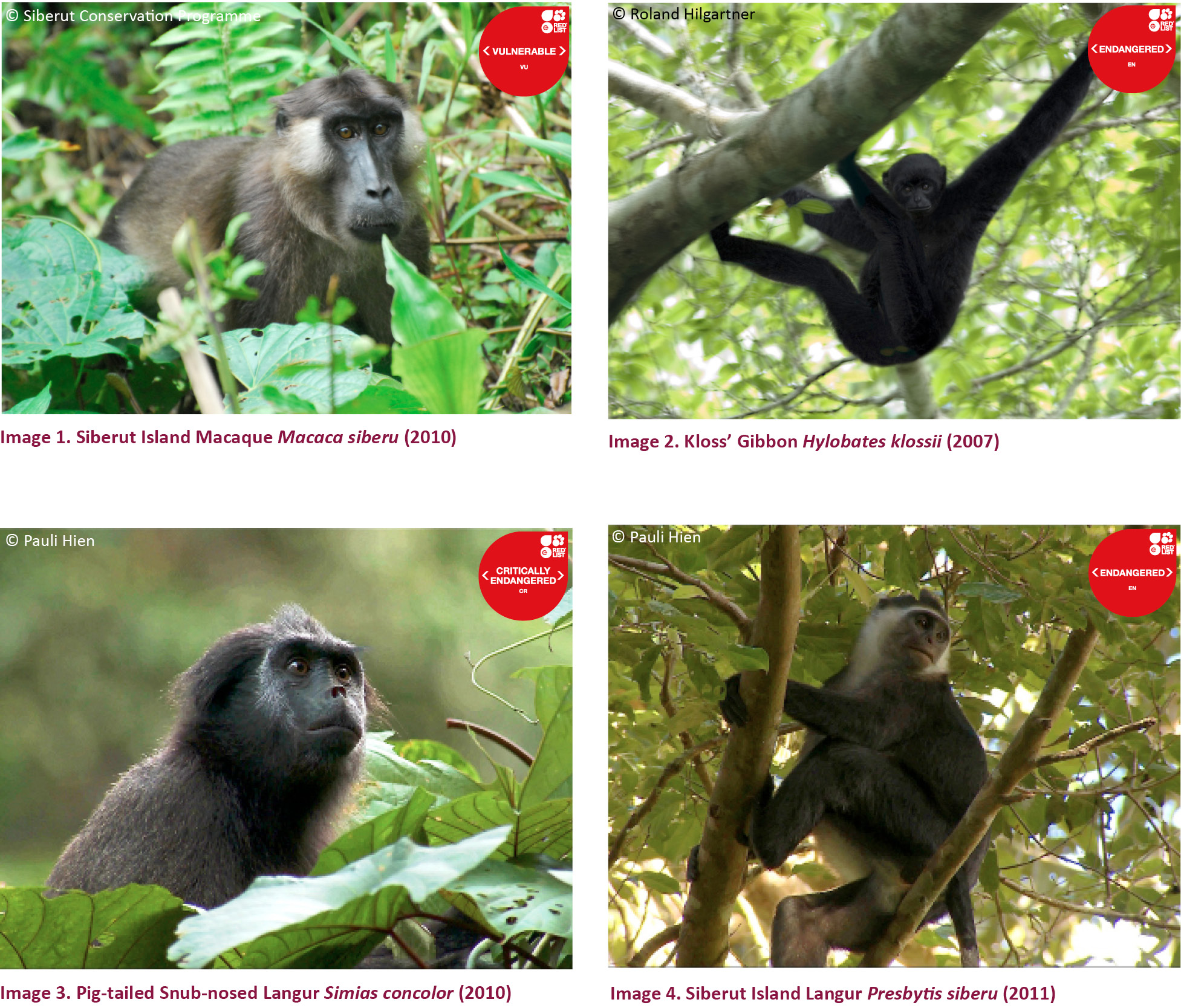
Whilst hunting of primates on the Mentawais is generally acknowledged to be extensive (Whittaker 2006), its impact on the primate populations remains poorly understood. Historically, primate hunting and the consumption of their meat were an important part of the ceremonies and rituals associated with the animistic belief system of the Mentawai people (Nooy-Palm 1968). The use of simple bow and poison arrow as the predominant hunting tool along with a complex set of customary regulations are believed to have prevented over-exploitation in the past (Mitchell 1982). However, as a result of early missionary influences, government resettlement schemes and the increasing use of modern firearms, traditional attitudes to hunting have progressively eroded (Tenaza 1987; Whittaker 2005). Without the cultural restraints of former times, hunting is now generally accepted as a significant influence on the distribution and abundance of Mentawai primates (Watanabe 1981; Mitchell 1985; Fuentes 2002) and for some species (e.g., Simias) it is even viewed as the single greatest threat (Whittaker 2006). Unfortunately, most of these accounts of hunting in the Mentawais are anecdotal, and where quantitative data are available, they are either limited, based on questionable methodology (i.e., counting of trophy skulls - WWF 1980; Whitten & Whitten 1982; Mitchell & Tilson 1986) or on data covering a restricted geographic area on the islands of North and South Pagai (Paciulli 2004).
We conducted an island-wide questionnaire survey on Siberut, the largest and northernmost of the Mentawai Islands, with the objective of gaining greater insight into the attitudes of the indigenous inhabitants to local resource utilization, with particular reference to the practice of primate hunting. In addition to providing socio-demographic data on the survey participants, we were specifically interested in which primates were hunted, the reasons for hunting, current methods, hunting frequencies and whether there was a difference between the island’s protected area (Siberut National Park) and the rest of Siberut. From the data gathered, we further attempted an approximation of annual offtake from hunting for Siberut’s four primate species. In this way, we hope to generate information required to better gauge the significance of hunting as a threat to Siberut’s primate population and thus to support the development of future conservation action (plans) and initiatives for the region´s primates.
METHODS
Three survey teams were sent out to Siberut Island (0.55’–1055’S & 98035’–99020’E) from June to July 2012 to undertake questionnaire surveys at 50 villages, the distribution of the survey locations corresponding to the distribution of villages on Siberut. Since only men participate in primate hunting activities (see e.g., Mitchell & Tilson 1986), we surveyed a total of 400 randomly selected men 18 years or older. All households within a given village were mapped, listed and sample households were then randomly selected using a set interval and a random start-point. A single adult member from each household was chosen for the interview, again on a random basis. Village size was taken into account while undertaking the surveys such that at larger villages (> 75 households) 15 interviews were administered, 10 at mid-sized villages (30–75 households), and five at smaller villages (< 30 households).
In order to ensure that the meaning and context of the survey questions were properly understood by the respondents, all interviewers received intensive training during a 3-day workshop that included simulated interviews with workshop participants, test interviews with locals in real-life situations and in-depth discussions of test results. Each team was led by a person with prior survey experience and, to minimize the development of distrust that Mentawai people can exhibit towards non-Mentawai visitors, all interviewers were recruited from the Siberut population. In addition “control questions” included in our questionnaire indicated consistency in individual responses, suggesting that truthful answers were generally given.
Data collection was conducted through personal, face-to-face interviews, using a structured questionnaire which included both closed-and open-ended questions relating to (i) household socio-demographics, (ii) natural resource use, and (iii) hunting practices. All interviews were conducted with the consent of the respondents, who were assured confidentiality. Demographic and socioeconomic variables were collected alongside the main survey questions, including age, gender, religion, highest level of formal education, household size and occupation. Of a total of 400 interviewed households, 390 answered all socio-economic, hunting- and conservation-related questions.
Survey data were tabulated in QPSmr Insight V2012.2 and statistical tests were performed using Stata V11. Data were analysed as a full set (Siberut as a whole), and using a geographic stratification with two distinct sub-sets, i.e., a) Siberut National Park (SNP) and b) non-SNP (see Fig. 1) to assess potential differences between the protected area and the rest of the island. To test for such differences, chi-square statistics were calculated for nominal categorical variables; in case the expected cell sizes were five or less, Fisher’s exact test was applied. We examined ordinal dependent variables using Wilcoxon-Mann-Whitney tests. McNemar’s test was applied for analysing species-specific differences in hunting prevalence (which is hunted most), hunting reasons and -methods as well as Wilcoxon signed-rank test to assess differences in hunting frequency (how often hunted). We also used chi-square and Kruskal Wallis tests to evaluate the relationships between socio-economic variables (age, religion, education) and hunting-related variables (hunting reasons, -tools, and -frequency). Significant test results (p < 0.05) were followed by logistic regression analyses.
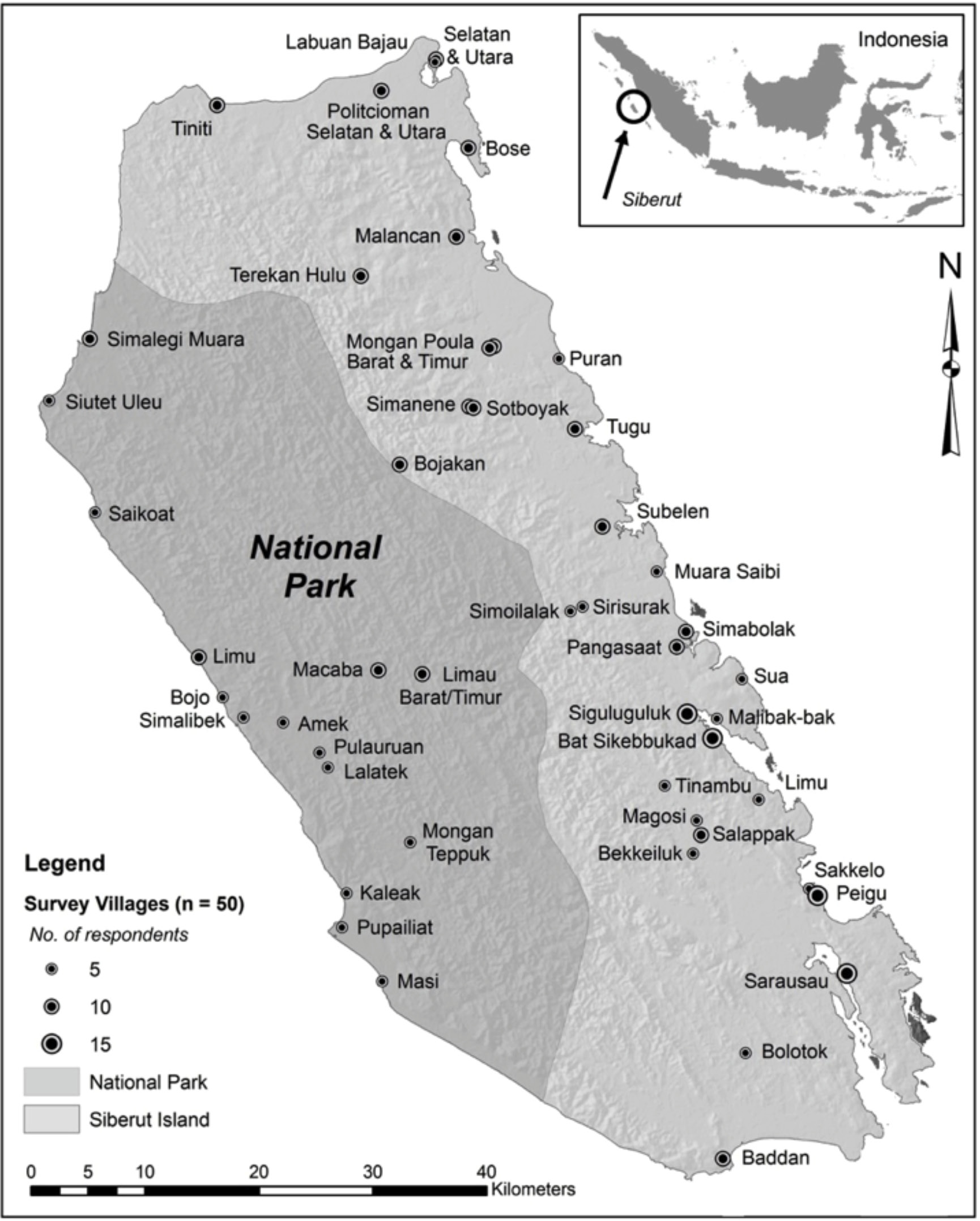

Using information obtained from our questionnaire, we attempted to approximate annual off-take rates per species as follows: the average number of primates per species taken in a 3-month period was multiplied by the total number of respondents still hunting that species. Values were then adjusted to represent primates taken/killed per hunting party instead of per individual since, almost without exception, primates are hunted by groups of several members of an extended family (clan or ‘uma’). Based on information gathered by ourselves and provided by K. Meyers and Y. Simalainge (personal communication), we assume a typical hunting party to comprise between four and eight members and accordingly, the data shown in Table 3 represent this range. Values for primates killed per hunting party per three months were then multiplied by four to represent off-take per annum and extrapolated from the 390 respondents to Siberut’s total population using government census data (BPSKKM 2011).
RESULTS
Socio-economics and Resource Use
Based on our socio-economic data a typical household on Siberut has an average of five members (5.3, range: 1–19), with an average of three children (3.6). As shown in Table 1, survey respondents were mostly of Christian faith (Catholic: 59%, Protestant: 26%), with Muslims accounting for 12% of the sample. The level of education was relatively low, with only 30% of respondents having secondary or tertiary education (junior high school: 18%, high school and university: 12%). Over half (52%) had only elementary education and 18% were without formal education. Almost everyone (95%) owned a small garden/field (‘ladang’) where they grow chocolate (95%), coconuts (84%), bananas (76%), taro (60%), sago (51%), vegetables (19%) and other crops (cloves, sweet potatoes, areca nut and rubber). Most also kept animals (78%), mainly chickens (98%) and pigs (30%); and less than 9% owned other animals (cattle, water buffalo, goats). Gathering forest products was an important activity, with about two-thirds of the men (64%) gathering wood and almost three-quarters (73%) mentioning other forest products such as rattan (60%), medicinal plants (24%), fruit (18%), and honey (14%). 14% said they collect tree bark and roots for poison arrows (hunting). More people carried out hunting (χ² = 44.1/p < 0.001), animal farming (χ² = 13.6/p < 0.001), gathering of wood (χ² = 21.4/p < 0.001) and other forest products (χ² = 21.7/p < 0.001), sago processing (χ² = 27.6/p < 0.001) and river fishing (χ² = 8.0/p = 0.005) within SNP than outside it.
Primate Hunting
Of the 390 respondents across all four survey regions, 38% (n=148) claimed they have hunted at some point in their lifetime, and 24%, (n=93) reported that they still do. The results for all hunting-specific questions are exclusively based on these 93 respondents. More hunters were above 40 years of age (60%) than in the total sample (53%), although this difference is not statistically significant.
Overall, there were no differences between SNP and the non-SNP area for any of the hunting-related variables (Table 2). Hunters mostly took S. concolor (77%), M. siberu (71%) and P. potenziani (68%) and there were no statistically significant differences between the capture frequencies for these species. H. klossii, on the other hand, was rarely hunted (3% of respondents; χ² > 60/p < 0.001) and was, therefore, not included in subsequent analyses.
The reasons for primate hunting are similar across species, with general consumption being reported most frequently (between 90% and 92%), followed by cultural/ceremonial reasons (52–56 %) while, recreation, improving one’s social status and trade were seldom given as a reason (all ≤ 14%).
Poison arrows were the main method for hunting primates throughout Siberut and are used by 84–89 % of all hunters, depending on the species. Older people (40+) used bow and arrow to hunt more often than younger people, which is statistically significant only for M. siberu (χ² = 7/p = 0.013) and P. siberu (χ² = 11.5/p = 0.001). Air rifles with poison pellets were also widely employed (72–75 %). The use of traps/snares differs significantly between the three species. They are mostly used for M. siberu (39% of the hunters; compared to S. concolor χ² = 21.0/p < 0.001; P. siberu χ² = 16.0/p < 0.001), less used for P. siberu (13% of the hunters; compared to M. siberu χ² = 7.0/p < 0.001), and hardly used for S. concolor (3%). Similarly, the use of hunting dogs is highest for the macaque (χ² = 6.4/p < 0.02).
Although 36–45 % of the current hunters said that they hunted sporadically (specifically in connection to traditional ceremonies), the data suggest that hunting occurred relatively frequently, with 15–20 % reporting that they hunt at least once in three months and 33–37 % reporting that they hunt twice or more within the same period. The hunting frequency neither differs between species nor with respect to age class, level of education or religion (Table 1).
As shown in Table 3, more than 85% of hunters take three or fewer animals. Most commonly, only a single animal is taken, with average numbers per three months ranging from 1.9–2.3 for S. concolor, M. siberu and P. siberu); gibbons are hunted very rarely (0.33 animals/3- month period). Extrapolating these data, and using a range in hunting party size of 4–8 members, we estimate that between 4,860–9,720 primates are killed every year on Siberut, including 1,620–3,240 Simakobu, 1,680–3,360 Joja, 1,550–3,100 Bokkoi and 12–24 gibbons.
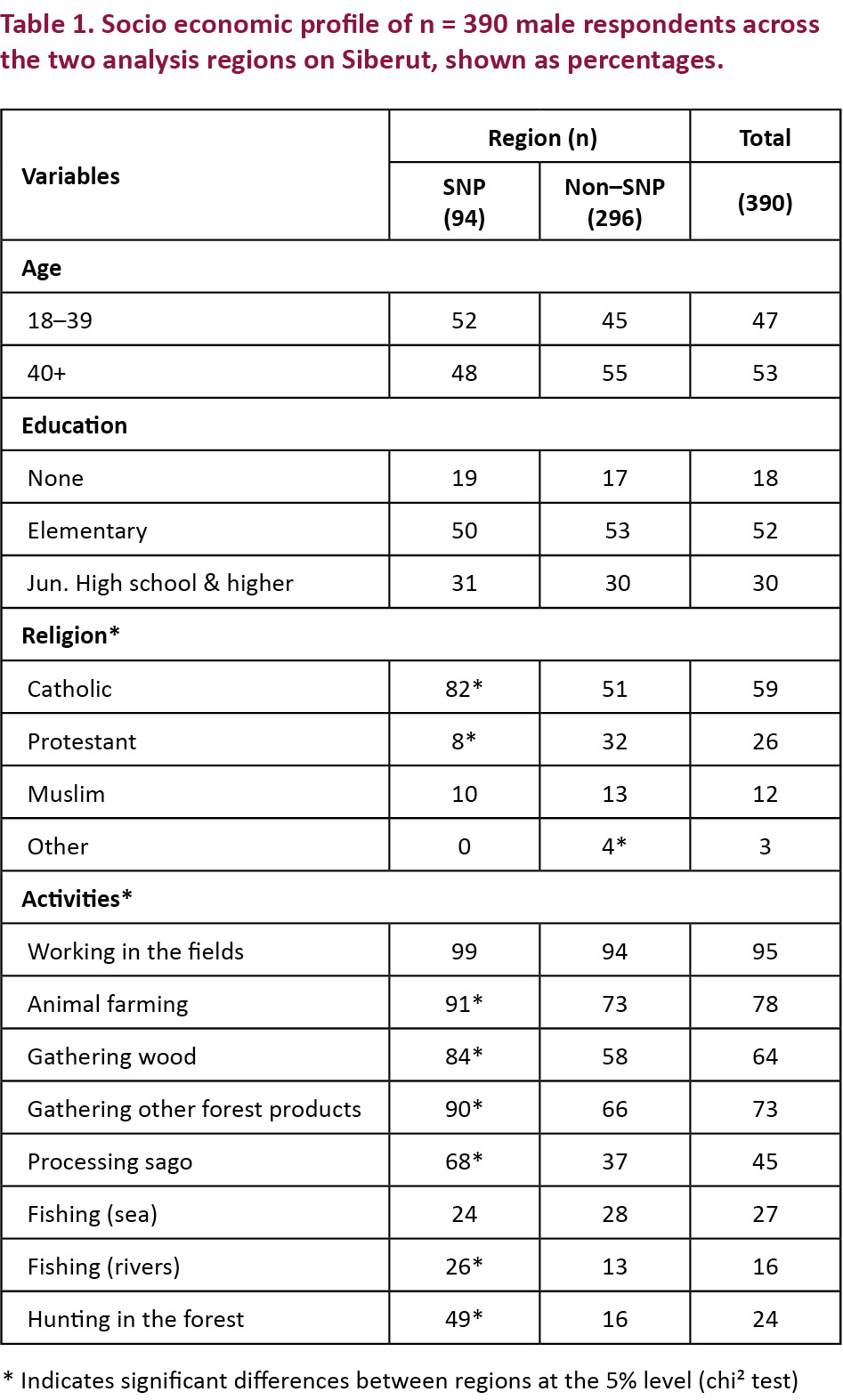

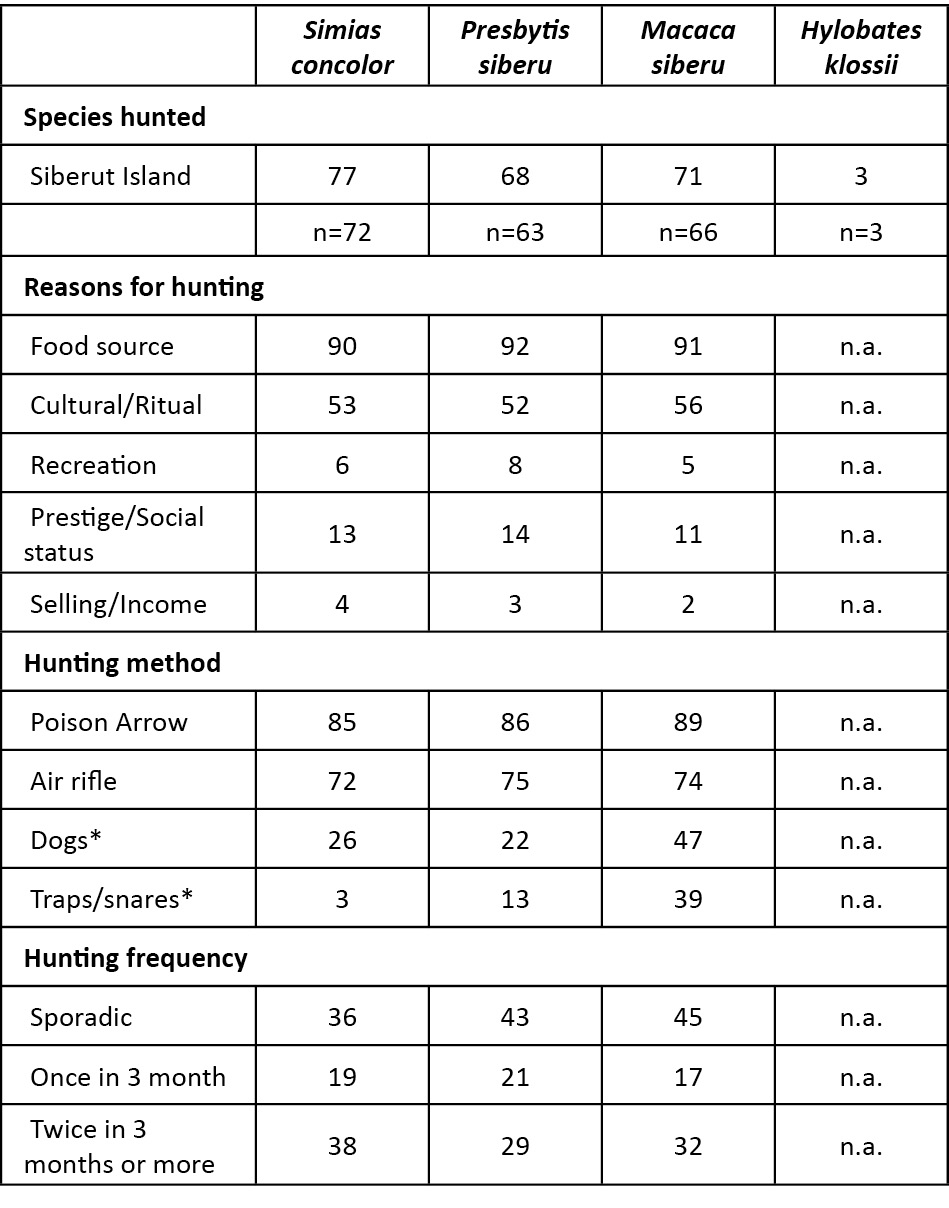

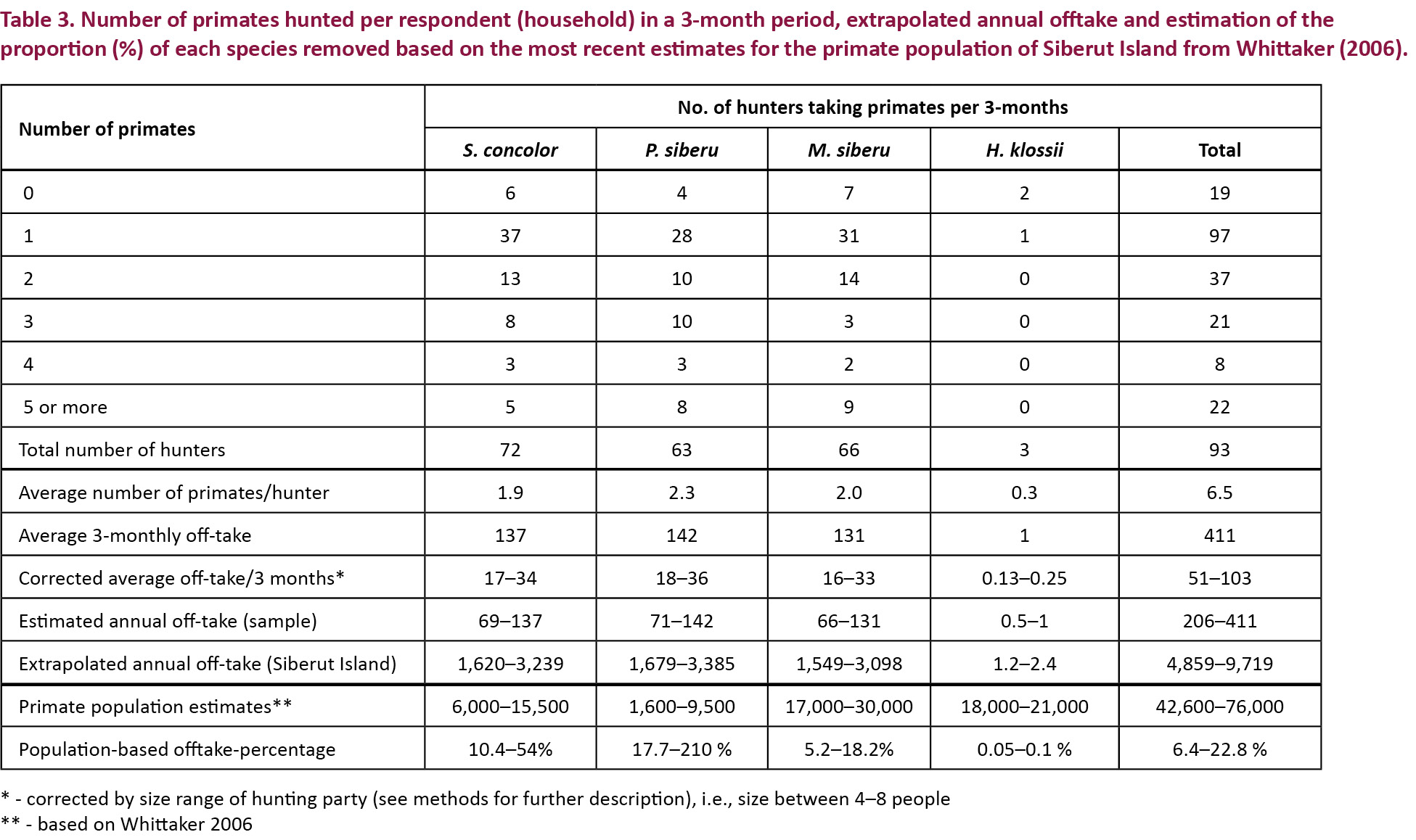
Attitudes towards primates and forest conservation
A majority of the respondents (41%) indicated that primates are now harder to find compared to recent years (Table 4); 31% report no change and only a minority feel that primates are easier to find now (16%). Almost 83% regard primate conservation as important - significantly more so in the National Park (χ² = 5.6/p = 0.018). Most of the respondents (72%) believe that the current forest area on Siberut is smaller than some years ago (more pronounced in people living outside the parks borders; z = 2.3/p = 0.021), while 23% responded that there was no marked change and 1% reported an increase. Almost all respondents (97%) agreed that forest conservation is important.
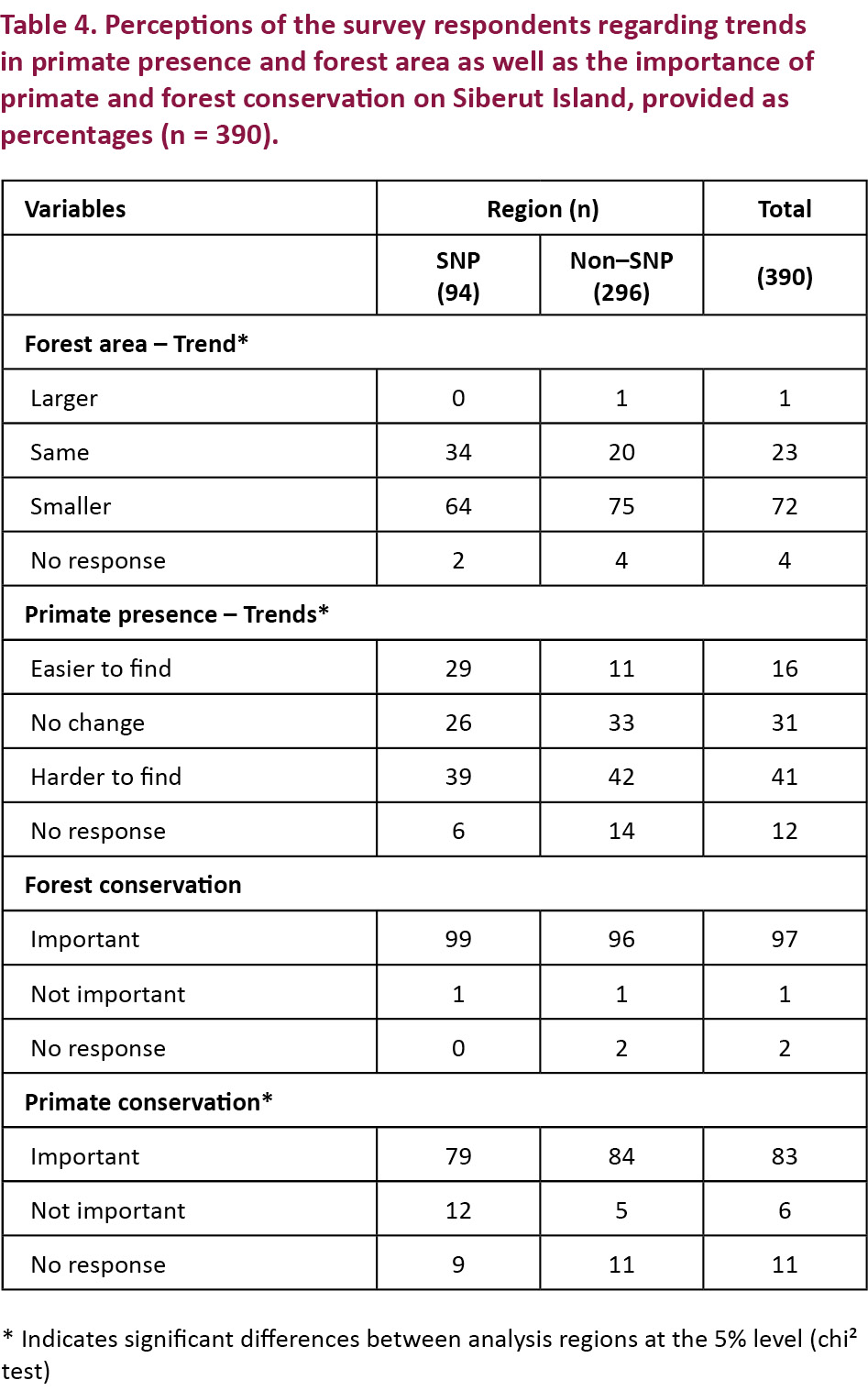
DISCUSSION
Our results emphasize that hunting is still an integral part of the culture of the Mentawai Islands, and specifically Siberut. It occurs relatively frequently and is geographically widespread, with the majority of the villages (> 75%) harbouring active hunters. Considering a total population of just under 35,100 in 2010 (BPSKKM 2011), we estimate the hunting community on the island to consist of around 2,270 individuals at the time of our survey.
Hunting of primates
S. concolor appears to be the hunters’ main target, which is in line with previous reports: It is considered by many to be the best tasting species and the easiest to hunt (Tilson 1979; WWF 1980; Mitchell & Tilson 1986), since its general predator response is to sit still rather than flee (Tilson 1977; WWF 1980). Surprisingly, over 70% of the respondents target macaques although their meat is generally considered unpalatable (Fuentes 2002). Most likely, the species is hunted because of its tendency to enter the people’s ladangs to steal crops and as such would be regarded as a pest (Paciulli 2004). This is also well known for the archipelago’s southernmost islands, where macaques (and Presbytis) are regularly poisoned with pesticides for this reason (Tenaza 1991). Conversely, the native gibbon is targeted by very few hunters, a finding similar to that of Tenaza & Tilson (1985), who reported that despite living at higher densities compared to the three other species, gibbons constituted a mere 4% of the primate skulls counted in the ceremonial houses inside their study area in central Siberut. Beside gibbon meat being considered distasteful (Tilson 1974 in Mitchell & Tilson 1986; Whittaker 2005), the main reason for low gibbon hunting frequency is probably that they are the most difficult primates to catch. Being exclusively arboreal, they often sleep in liana-free emergent trees, which makes them inaccessible to hunters (Tilson & Tenaza 1982). Also, they move rapidly in the canopy when alerted and produce loud predator-specific alarm calls, which can potentially alert other primates in the area (Tilson & Tenaza 1977; Tenaza & Tilson 1985). Furthermore, religious taboos generally forbade the hunting of H. klossii in former times (Mitchell & Tilson 1986), and despite the on-going erosion of cultural tradition, it is plausible that in those places where cultural traditions are not formally observed anymore, traditional values continue to live on as customary practice.
Methods of hunting were similar for all species, except for the high amount of trapping reported for macaques, a finding not entirely surprising, since it is the only primate on Siberut that habitually spends time on the ground (Whitten & Whitten 1982). More surprising, however, is that, although the use of air-rifles has increased over recent years and is now widespread, bow and poison arrows still remain the primary tool for hunting all four primate species. Whether this is related to the government’s 1987 ban on air rifles (although not enforced on Siberut; Tenaza 1988) or to actual preferences and the desire to maintain traditional elements in hunting practice is not clear from our survey. Our finding that hunters under the age of 40 use bows and arrows less often compared with older hunters, suggests however, that traditional practices are indeed on the decline. In this context it is noteworthy that some of our respondents explicitly stated that the rules which used to govern the hunts are less observed nowadays.
It is interesting that consumption was most often given as the reason for hunting and indeed a successful hunt would yield primate flesh as a supplemental source of animal protein. However, given the numbers and frequency of primates hunted, they can only form an occasional part of the local diet, much more important sources of animal protein being fish (incl. shellfish and crustacean) with lesser amounts of pork and chicken (data from present study). Considering that between 36–56 % of respondents acknowledge they hunt for cultural/ceremonial reasons, it may be that primate flesh still has a more symbolic, cultural value and that eating it on occasion is an important part of Mentawaian social life.
While in other countries primates are often hunted to be sold as ‘bushmeat’ in local markets (cf. Franzen 2006; Fa & Brown 2009), on Siberut only 2–3 % of the hunters reported selling primates. Further, of those traded, it remains unclear whether they are being sold for consumption or as pets, although only 1 out of all 390 respondents specifically indicated the use of primates as pets. In this respect, our data does not support the suggestion of Whittaker (2006) that the pet trade is a driver of primate population decline in the Mentawais, at least on Siberut.
In general, differences in our survey data between the National Park and the rest of Siberut were small. Our results show a greater prevalence within the park’s borders of hunting, sago processing, gathering of wood and NTFPs, river fishing and animal farming compared to the outside area, suggesting that the park’s inhabitants live a more subsistence-based lifestyle. Located on the more remote western side of the island, this would be expected. It is, however, alarming that hunting is actually higher in the park. Considering its division into three land-use zones, with hunting being forbidden in the sanctuary zone and limited by permits in another (traditional use zone; PHPA 1995), we would have expected levels of hunting to be lower compared to the outside. That this is not the case calls for improved hunting related management strategies.
Off-take estimates
Our figures for off-take are based on an assumption regarding hunting party size, and therefore need to be viewed with a degree of caution. Nevertheless, the estimate of 4,800–9,700 primates per year is useful as it not only represents the first attempt to directly quantify hunting activities on Siberut, but also in indicating that the numbers of primates taken in this way are substantial. The impact that removal on such a scale has on Siberut’s primate population as a whole, and more importantly on the individual species, is difficult to assess, as this depends on a variety of interrelated factors including current size and recent trends in the populations of each species, age and sex of animals killed, changes in availability of suitable forest habitat and rate of human population growth and distribution, information on all of which is sparse and unreliable. Using the most recent population estimates for Siberut (Whittaker 2006), our figures indicate between 6 and 22% (see Table 3) of the primate population is lost annually to hunting. Although the gibbons seem to be relatively unaffected by hunting, and the impact on the macaques remains comparatively low, we estimate that no less than 10–17 % of the estimated populations of the two langur species are removed through hunting activities each year. Furthermore, since most available data indicate that populations of all primates are in decline (e.g., Tenaza 1990; Fuentes 1996; Whittaker 2006; this survey), the impact of hunting is likely to increase in the future, this effect being further exacerbated by continued increases in the human population (ca. 2.2% growth per annum: BPS 2002; BPSKKM 2011) and associated demands on forest habitat.
Conservation implications
While our data do not allow robust conclusions about the sustainability of hunting on Siberut, they clearly indicate that hunting of primates is a widespread and frequent activity that is responsible for the removal of substantial numbers of three of the island’s four species. At the same time, our results show that hunting is likely to be of little consequence for the local gibbon. In general, our findings underscore the importance of considering hunting and its impact when conducting population viability assessments and in the development of population management plans for Siberut’s primates. Although hunting alone may pose little immediate threat, its significance in combination with a continued decline in available primate habitat, further reduction in overall primate population size and an increase in a less-traditionally oriented human population, should not be underestimated and measures to address the impact of hunting on Siberut’s primate populations need to be taken now.
Given the cultural value that hunting of primates still has, together with the fact that virtually all of what is hunted is for local use, we support the view presented in earlier reports (WWF 1980; PHPA 1995), that the local conservation challenge is not to eliminate hunting per se, but to establish measures to limit its impact on primate populations. Since attempts to abolish the hunting tradition are bound to incur the anger of the traditional communities and thus prevent further efforts to constructively improve the situation, we advocate a combined approach which would include: (i) lobbying the local government to ban the use and possession of air rifles throughout the archipelago, and confiscate such weapons; (ii) an island-wide campaign to emphasize cultural tradition in order to increase the hunters’ inclination to follow traditional practices and taboos, including ceremonial rather than opportunistic hunting; (iii) improving agricultural practices to decrease dependence on primates for animal protein; (iv) active inclusion of locals into conservation projects and environmental tourism ventures on Siberut as guides and field assistants (cf. Corlett 2007) who can act as multipliers for a positive conservation message in their communities; (v) conservation education and outreach targeted at communities in areas of particular importance to primate conservation (e.g., National Park) delivered through local schools, informal groups and village leaders to consolidate the largely positive image that Siberut’s human population generally holds of the local primates.
References
Bodmer, R.E., J.F. Eisenberg & K.H. Redford (1997). Hunting and the Likelihood of Extinction of Amazonian Mammals. Conservation Biology 11(2): 460–466.
BPS - Biro Pusat Statistik (2002). Mentawai dalam Angka. Kabupaten Kepulauan Mentawai,Tuapejat. (Unpublished report).
BPSKKM - Badan Pusat Statistik Kabupaten Kepulauan Mentawai (2011). Kepulauan Mentawai in Figures 2011. Regional Development Planning Board of Kepulauan Mentawai, Tuapejat, Sipora. <http://mentawaikab.bps.go.id/livebeta/?p=104>. Downloaded on 20.02.2013.
10.1111/j.1744-7429.2007.00271.x
Dela, J.D.S. (2011). Impact of monkey-human relationships and habitat change on Semnopithecus vetulus nestor in human modified habitats. Journal of the National Science Foundation Sri Lanka 39(4): 365–384; http://dx.doi.org/10.4038/jnsfsr.v39i4.4144
& (2009). Impacts of hunting on mammals in African tropical moist forests: a review and synthesis. Mammal Review 39(4): 231–264; http://dx.doi.org/10.1111/j.1365-2907.2009.00149.x
Franzen, M. (2006). Evaluating the sustainability of hunting: a comparison of harvest profiles across three Huaorani communities. Environmental Conservation 33(1): 36–45; http://dx.doi.org/10.1017/S0376892906002712
Fuentes, A. (1996). “Current status and future viability for the Mentawai primates.” Primate Conservation 17: 111–116.
Fuentes, A. (2002). Monkeys, humans and politics in the Mentawai Islands: no simple solutions in a complex world, pp. 187–207. In: Fuentes, A. & L.D. Wolfe (eds.). Primates Face to Face: Conservation Implications of Human-Nonhuman Primate Interactions. Cambridge, Cambridge University Press.
Goeltenboth, F. & K.H. Timotius (1993). Impact of rainforest destruction - The Siberut Island Case, Sumatra, Indonesia, pp. 425–433. In: Edwards, D. S., W.E. Booth & S. C. Choy. Tropical Rainforest Research - Current Issues. Dordrecht / Boston / London, Kluwer Academic Publishers.
IUCN (2014). IUCN Red List of Threatened Species. Version 2014.2. URL: <www.iucnredlist.org>; Downloaded on 02 August 2014.
Mitchell, A.H. (1982). Siberut Nature Conservation Area, West Sumatra, Management Plan 1983–1988. WWF Report for the Directorate of Nature Conservation Perlindungan dan Pelestarian Alam Republic of Indonesia. Bogor, Indonesia, 121pp.
Mitchell, A.H. (1985). Human predation of primates in the Mentawai Islands, Indonesia. International Journal of Primatology 5(4): 362.
Mitchell, A.H. & R.L. Tilson (1986). Restoring the balance: traditional hunting and primate conservation in the Mentawai Islands, Indonesia, pp. 249–260. In: Else, J.G. & P.H. Lee (eds). Primate Ecology and Conservation. Cambridge University Press, New York.
Mittermeier, R.A., C. Schwitzer, A.B. Rylands, L.A. Taylor, F. Chiozza, E.A. Williamson & J. Wallis (eds.) (2012). Primates in Peril: The World’s 25 Most Endangered Primates 2012–2014. IUCN/SSC Primate Specialist Group (PSG), International Primatological Society (IPS), Conservation International (CI), and Bristol Conservation and Science Foundation, Bristol, UK, 40pp.
Nooy-Palm, H. (1968). The Culture of the Pagai-Islands and Sipora, Mentawei. Tropical Man 1: 152–241
Paciulli, L.M. (2004). The effects of logging, hunting, and vegetation on the densities of the Pagai, Mentawai Islands primates. PhD Thesis. Stony Brook University New York, 428pp.
PHPA (1995). Siberut National Park Integrated Conservation and Development Management Plan (1995–2020). Volume I: Current Conditions and Evaluation. Chemonics International in association with PT. Indeco Duta Utama and PT. Nadya Karsa Amerta, for Ditjen Perlindungan Hutan dan Pelestarian Alam, Departemen Kehutanan, Republik Indonesia, Jakarta, 119pp.
Schefold, R. (1992). Shamans on Siberut: Mediators between the worlds, pp. 105–117. In: Lindsay, C. Mentawai Shaman: Keeper of the Rain Forest. Aperture, New York.
Tenaza, R.R. (1987). The status of primates and their habitats in their habitats in the Pagai Islands, Indonesia. Primate Conservation 8(104): 110.
Tenaza, R.R. (1988). The status of primates and their habitats in their habitats in the Pagai Islands, Indonesia: A progress report. Primate Conservation 9: 146–149.
Tenaza, R.R. (1991). Conservation of the Mentawai Islands’ primates, pp. 55–58. In: Ehara, A., T. Kimura, O. Takenaka & M. Iwamoto (eds.). Primatology Today, Elsevier Science Publishers, Amsterdam.
Tenaza, R. & R. Tilson (1985). Human predation and Kloss’s Gibbon (Hylobates klossii) sleeping trees in Siberut Island, Indonesia. American Journal of Primatology 8(4): 299–308; http://dx.doi.org/10.1002/ajp.1350080405
Tilson, R.L. (1977). Social organization of Simakobu (Nasalis concolor) in Siberut Island, Indonesia. Journal of Mammalogy 58(2): 202–122.
Tilson, R.L. (1979). Der Unbekannte Affe. Das Tier 5: 20–23.
Tilson, R.L. & R.R. Tenaza (1977). Evolution of long-distance alarm calls in Kloss’ Gibbon. Nature 268: 233–235; http://dx.doi.org/10.1038/268233a0
Tilson, R.L. & R.R. Tenaza (1982). Interspecific spacing between gibbons (Hylobates klossii) and langurs (Presbytis potenziani) on Siberut Island, Indonesia. American Journal of Primatology 2(4): 355–361; http://dx.doi.org/10.1002/ajp.1350020404
Watanabe, K. (1981). Variations in group composition and population density of two sympatric Mentawaian Leaf-Monkeys. Primates 22(2): 145–160; http://dx.doi.org/10.1007/BF02382606
Whittaker, D.J. (2005). Evolutionary genetics of Kloss’s Gibbons (Hylobates klossii): Systematics, phylogeography, and conservation (Indonesia). PhD Thesis. Graduate Faculty in Anthropology. City University of New York, New York, 201pp.
Whittaker, D.J. (2006). A Conservation Action Plan for the Mentawai Primates. Primate Conservation 20: 95–105; http://dx.doi.org/10.1896/0898-6207.20.1.95
Whitten, A.J. & J.E.J. Whitten (1982). Preliminary observations of the Mentawai Macaque on Siberut Island, Indonesia. International Journal of Primatology 3(4): 445–459; http://dx.doi.org/10.1007/BF02693743
Wilson, D.E. & D.A. Reeder (eds.) (2005). Mammal species of the world: a geographic and taxonomic reference, 3rd Edition. The John Hopkins University Press, Baltimore, MD, USA, 2142pp.
WWF (1980). Saving Siberut: A Conservation Master Plan. WWF Indonesia Programme, Bogor, Indonesia, 135pp.
